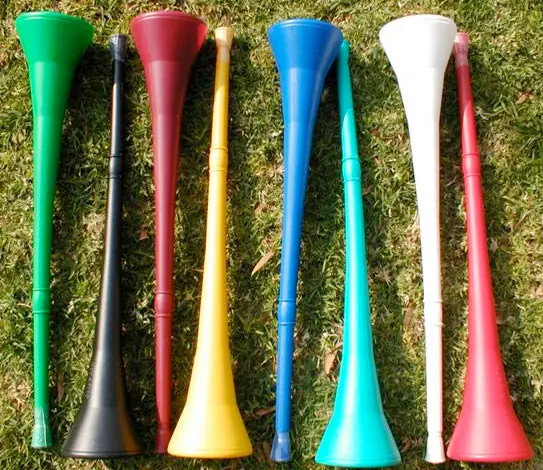Soccer World Cup: the Power of the Vuvuzela
That blaring sound coming from the stands of the South African stadiums playing host to World Cup matches is the produce of a horn called the vuvuzela.
 This horn has a long and proud history in South Africa, the host nation for the 2010 soccer World Cup. Tradition has it that in ancient times, a horn of similar make and sound (sometimes called a kudu) was used to summon people to tribal gatherings. Such horns have been used at various times over the years for similar purposes. After the end of apartheid, the vuvuzela came to be seen by many people as a symbol of South African unity.
This horn has a long and proud history in South Africa, the host nation for the 2010 soccer World Cup. Tradition has it that in ancient times, a horn of similar make and sound (sometimes called a kudu) was used to summon people to tribal gatherings. Such horns have been used at various times over the years for similar purposes. After the end of apartheid, the vuvuzela came to be seen by many people as a symbol of South African unity.
One version of events has the horn being invented out of an aluminum bicycle horn. Now, however, all vuvuzelas are made of plastic.
The vuvuzela (also called a lepatata) comes in different sizes, ranging up to one meter (39 inches) in length. The horn comes in many colors as well.
The horn creates a very loud monotone (B-flat, for the musically curious). A similar instrument (commonly called a cornet) is used in South American countries.
 The loudness of the sound coming out of the vuvuzela has been the source of some controversy. Previous versions of the colorful horn emitted sound up to 127 decibels (which is quite high and quite hard on the ears, especially since the soccer stands are usually filled with people blowing on the horns). Some people have reported hearing loss after being subjected to the noise for an extended period of time.
The loudness of the sound coming out of the vuvuzela has been the source of some controversy. Previous versions of the colorful horn emitted sound up to 127 decibels (which is quite high and quite hard on the ears, especially since the soccer stands are usually filled with people blowing on the horns). Some people have reported hearing loss after being subjected to the noise for an extended period of time.
A new version of the horn, however, boasts a modified mouthpiece that lowers the decibel level of the sound being emitted. (This version was introduced only recently, however, and it is likely the vast majority of horns being blown in stadiums at the World Cup are of the old-style, louder variety.)




 This horn has a long and proud history in South Africa, the host nation for the 2010 soccer World Cup. Tradition has it that in ancient times, a horn of similar make and sound (sometimes called a kudu) was used to summon people to tribal gatherings. Such horns have been used at various times over the years for similar purposes. After the end of apartheid, the vuvuzela came to be seen by many people as a symbol of South African unity.
This horn has a long and proud history in South Africa, the host nation for the 2010 soccer World Cup. Tradition has it that in ancient times, a horn of similar make and sound (sometimes called a kudu) was used to summon people to tribal gatherings. Such horns have been used at various times over the years for similar purposes. After the end of apartheid, the vuvuzela came to be seen by many people as a symbol of South African unity. The loudness of the sound coming out of the vuvuzela has been the source of some controversy. Previous versions of the colorful horn emitted sound up to 127 decibels (which is quite high and quite hard on the ears, especially since the soccer stands are usually filled with people blowing on the horns). Some people have reported hearing loss after being subjected to the noise for an extended period of time.
The loudness of the sound coming out of the vuvuzela has been the source of some controversy. Previous versions of the colorful horn emitted sound up to 127 decibels (which is quite high and quite hard on the ears, especially since the soccer stands are usually filled with people blowing on the horns). Some people have reported hearing loss after being subjected to the noise for an extended period of time. 

